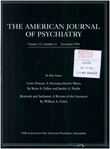Depression and Parkinson's disease: a review
Abstract
OBJECTIVE: The purpose of this review is to provide an update of the research regarding depression in Parkinson's disease and to synthesize the information into a neurobiological model relating the structural and biochemical changes in this disorder to the behavioral manifestations. METHOD: The author used a computer-based search of the literature, augmented by extensive bibliography-guided article reviews, to find information on depression and Parkinson's disease. FINDINGS: Depression occurs in approximately 40% of patients with Parkinson's disease; depression in Parkinson's disease is distinguished from other depressive disorders by greater anxiety and less self-punitive ideation. Lower CSF levels of 5-hydroxyindoleacetic acid, a past history of depression, and greater functional disability are associated with a greater risk of depression in Parkinson's disease. Female gender, early age at onset of Parkinson's disease, and greater left brain involvement may also be risk factors. Approximately half of depressed patients with Parkinson's disease meet criteria for major depressive episodes; half have dysthymia. Depression is more common in Parkinson's disease with prominent bradykinesia and gait instability than in tremor-dominant syndromes. Depressed patients with Parkinson's disease have greater frontal lobe dysfunction and greater involvement of dopaminergic and noradrenergic systems than nondepressed patients with the disease. Mood changes in Parkinson's disease respond to treatment with conventional tricyclic antidepressants or ECT. CONCLUSIONS: Neurobiological investigations suggest that depression in Parkinson's disease may be mediated by dysfunction in mesocortical/prefrontal reward, motivational, and stress-response systems. Neuropsychological, metabolic, clinical, pharmacological, and anatomical studies support the involvement of frontal dopaminergic projections in patients with Parkinson's disease and depression.
Access content
To read the fulltext, please use one of the options below to sign in or purchase access.- Personal login
- Institutional Login
- Sign in via OpenAthens
- Register for access
-
Please login/register if you wish to pair your device and check access availability.
Not a subscriber?
PsychiatryOnline subscription options offer access to the DSM-5 library, books, journals, CME, and patient resources. This all-in-one virtual library provides psychiatrists and mental health professionals with key resources for diagnosis, treatment, research, and professional development.
Need more help? PsychiatryOnline Customer Service may be reached by emailing [email protected] or by calling 800-368-5777 (in the U.S.) or 703-907-7322 (outside the U.S.).



